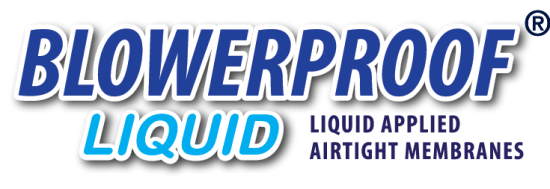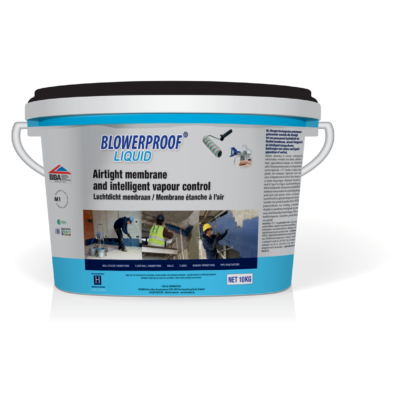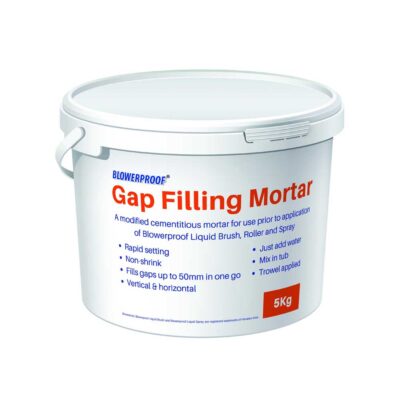A guide to achieving retrofit airtightness
• Air leakage is a major cause of energy loss, typically around 20% in older houses, from space heating. In modern houses, where heat loss is less through other means, ventilation counts for a higher proportion – estimated at between 35 – 40%.
• Older houses tend to be more airtight than more modern houses – this might be because of the less precise nature of modern workmanship and materials assembly.
• Air leakage is the uncontrolled movement of air in to and out of a building which is not for the specific and planned purpose of exhausting stale air or bringing in fresh air.
• Air leakage is measured as the rate of leakage per m2 of external envelope per hour at an artificial pressure differential through the envelope of 50 Pa. i.e. x m3/hr/m2@50Pa
• The Building Regulations 2006 standard is 10 m3/hr/m2
• EST ‘Good Practice’ air permeability is 5m3/h/m2. ‘Best practice’ is 3m3/h/m2 (based on CIBSE Tm23 2000).
• The AECB Gold Standard is 0.75m3/h/m2@50Pa.
• In a recent survey of 100 new houses, none achieved a best practice standard and around a third failed to achieve the Building Regs. standard. Less than 20% achieved the good practice standard of 7 m3/hr/m2
• Ensuring airtightness is achieved through careful implementation of strategy throughout the design and construction phases.
• ‘Build tight – ventilate right’
Where it all goes…..

| 1 | Around the ends of floor joists or joist hangers |
| 2 | Beneath inner window sills and around window frames |
| 3 | Through windows and/or hollow window frames |
| 4 | Through and around doors – particularly double doors |
| 5 | Beneath doors and doorframes |
| 6 | Along the top and bottom edges of skirting boards |
| 7 | Between and around sections of suspended floors, usually timber floorboards |
| 8 | Around loft hatches |
| 9 | Through the eaves |
| 10 | Around rooflights |
| 11 | Through gaps behind plasterboard on dabs or hollow studwork walls |
| 12 | Cracks or holes through a masonry inner leaf |
| 13 | Around supplies from external meter boxes |
| 14 | Around wall mounted fan or radiant heaters; around and through fused spurs and pull switches |
| 15 | Gaps around boiler flues |
| 16 | Around water and heating pipes that penetrate into hollow floor voids and partition walls |
| 17 | Around waste pipes passing into floor voids or boxed in soil stacks |
| 18 | Around waste pipes passing through walls |
| 19 | Gaps around heating pipes |
| 20 | Around and through recessed spotlights |
| 21 | Around waste pipes, gas and water supplies, cables, which penetrate the lower floor |
| 22 | Around vent pipes passing through to loft void |
| 23 | Through MVHR or warm air heating systems; around terminals |
| 24 | Gaps around pipes to cold water and/or heating header tanks |
| 25 | Around and through wall-mounted extract fans, cooker hood vents, tumble dryer vents |
| Other routes | |
| 26 | Around and through ceiling roses |
| 27 | Through room thermostats and heating controllers |
| 28 | Behind polystyrene coving along wall to roof joints |
| 29 | Through key holes and where locks and bolts prevent effective draught proofing |
| 30 | Around internal timber joists that penetrate plaster walls |
| 31 | Through subfloor air supplies to solid fuel heaters |
| 32 | Through gaps in the casings of MVHR units |
| 33 | Up chimneys, particularly where flue dampers are not fitted |
| 34 | Through air bricks and partially closable hit-and-miss vents |
| 35 | Through window spinner vents |
| 36 | Around and through closed trickle vents |
Achieving Air tightness
 |
Air barriers must be impermeable to air, continuous, durable and accessible. Internal air barriers need to be airtight; External air barriers need to be wind-tight Air barriers can be vapour open but require careful specification of adjoining construction and insulation materials. Having made the building airtight, mechanical ventilation is essential. |
 |
Laps in membranes should be rigorously sealed. Run a layer of double sided tape between the membranes at the overlap and run a tape over the leading edge of the outer sheet. Ensure that laps are positioned over a supporting area eg studs that can be battened for added security. Special wind and airtight membranes are available complete with adhesives, adhesive tapes and service penetration seals. |
 |
When installing / reinstalling a window/door frame, ensure that the gaps around the frame are sealed. Gunned in compatible sealant is suitable for small joints, not forgetting joint cleaning and priming to ensure a good bond, but where the openings are larger, use a pre-compressed flexible expanding foam strip. Ensure that the airtight membrane meets and overlaps the seal to maintain the airtight layer overall. Do not use foaming gap-filling adhesives, they shrink and break the seal after the tests are complete. |
 |
Use compatible gunned in sealant to seal joints between door / window frames and the surrounding wall externally. Internally, apply sealant to gaps between the wall reveals / window boards and the window / door units. |
 |
Draughtstrip existing windows and external doors. (Do not draughtstrip to kitchens and bathrooms unless extract ventilation is provided.) Use synthetic rubber or elastomeric tubular seals. Use brush seals with sash windows. |
 |
Draughtstrip the loft hatch. Ironmongery should be specified to ensure seals are compressed. NB Check that the hatch is thermally insulated as well as the rest of the ceiling. |
 |
Seal holes around services passing through the external wall including water, drainage, gas pipes, boiler flues and electrical cables. (Ensure that the sealant around boiler flues is heat resistant) |
 |
Seal holes around service pipes passing through suspended timber floors. |
 |
Seal holes around light fittings and pull cords in the ceiling. If the light fitting is not airtight then install an airtight box over the light fitting in the ceiling void. Choose airtight light fittings. |
 |
Block up redundant fireplaces and insert vent. Cap the chimney. Make sure the blocking up material is thermally insulating to reduce excessive heat losses. |
 |
Drylining is notoriously air leaky, consider parge coating the wall for airtightness before drylining. When drylining directly to an external wall, apply a continuous perimeter of adhesive. Ensure the joints between boards are sealed |
 |
Lay room-conditioned hardboard over existing square-edged floor boards. Seal the perimeter. |
 |
Seal the joint between the ceiling and the external wall Seal the joint between drylining and skirting board |
The ‘Airtightness barrier’
• A continuous airtightness barrier system is the combination of interconnected materials, flexible sealed joints and components of the building envelope that provides the airtightness of the building enclosure and the separateness of heated and unheated spaces.
• The airtightness barrier needs to be designed into the building envelope during the initial concept design stage.
Developing an airtightness strategy
At the design stage
• Define an airtightness performance target.
• Use a performance specification.
• Ensure all trade specifications include their requirements and interfaces with other trades.
• Ensuse all ME&P service engineer’s specifications include airtightness requirement and measures to achieve it.
• At an early stage of the design, define the line of the airtightness barrier.
• It can be useful to take plans and sections and draw a continuous red line that passes through all the elements that separate heated and unheated spaces thus:

• It is useful at an early stage to identify critical details that will have a bearing on the airtightness barrier.
• Details should be thoroughly worked out at design stage and not ‘left-to-chance’ later on site.
• Think in 3D and explore around every corner.
• Clearly identify the location of the air barrier on the drawings as an ‘airtightness line’.
• Tightly manage the design implementation by appointing an ‘Airtightness Champion’ to coordinate between consultants and to coordinate with the contractor’s ‘Airtightness Champion’ who will coordinate between trade sub-contractors.
• If the design team is inexperienced, it might also be prudent to appoint an independent adviser.
• Specify airtight components, membranes, seals and jointing methods.
• Check interfaces between components and between trades or work packages to ensure the continuity of the air barrier.
On site
• Tightly manage the implementation by appointing a contractor’s site ‘Airtightness Champion’ to coordinate between trade subcontractors and to coordinate with the design team’s ‘Airtightness Champion’ who will coordinate between consultants.
• Toolbox talks: Brief the construction team of the importance of airtightness and their collective role in achieving it.
• Clearly identify the location of the air barrier.
• Institute a regimen of inspection during construction, with particular regard to ensuring the air barrier is uncompromised by shoddy workmanship.
• Consider using airtightness testing kit during construction so all trades are aware of the effect of their work and encourage engagement in the quest for airtightness.
• Ensure that the air barrier is complete prior to covering up by other work and trades – failures found during testing can lead to expensive uncovering and remedial work.
• Ensure that air testing is scheduled in advance to achieve maximum benefit for purposes of remedial work.
The designer’s work plan
The role of the designer is critical. Design for air tightness should be simple and buildable. Targets should be achievable. Roles and responsibilities should be established at an early stage. The Contractor should be made responsible for achieving the designed Air tightness levels.
| RIBA Work Stage | Design Team Tasks |
| A Appraisal | Establish an airtightness performance target/air permeability rate. |
| B Feasibility / Briefing | Note Microclimate Test existing buildings / building to be refurbished / extended Identify procedure for review and testing |
| C Outline proposals | Consider air tightness issues in relation to decisions about form of construction |
| D Detailed Proposals | Identify requirement of additional consultants / design by specialists |
| E Final Proposals | Ensure co-ordination between Design Team to ensure airtight envelope & penetrations Detailed application of airtight materials, junctions, service penetrations |
| F Production Info | Select sub-contractors for specialist works (incl. testing) Careful specification of components, membranes, materials Emphasise methods for airtightness in documentation Show airtightness line on drawings and details Emphasise responsibilities in specification for dealing with ‘loose ends’ between sub-contractor interfaces |
| G Tender Documentation | Define Contractors’ responsibilities for coordinating work sequences |
| H Tender Action | Ensure selected tenders include adequate airtightness procedures |
| J Mobilisation | Brief all involved in areas critical to air infiltration before work starts Preparation of samples, training, testing and QA procedures |
| K-L Site Works | Co-ordinate inspection with Building Control if required Ensure inspection of areas to be covered Ensure audits and testing schedule is adhered to Ensure design changes do not compromise Air tightness performance |
| M Post Completion | Obtain feedback from occuspants concerning comfort and energy consumption Carry out remedial work as required at end of Defects Liability Period. |
| Source: Design and Detailing for Air tightness, Chris Morgan, SEDA 2006 | |
Testing
• Air testing is a crucial tool in determining the effectiveness of an airtightness membrane.
• Air testing is carried out when the envelope is complete. If possible, it is wise to test twice – once before the covering-up of the membrane when remedial work can easily be carried out, and again at completion.
• Testing will identify the overall ‘leakage’ of the building.
• Smoke generating sticks can be use to find air leakage points or lines and help in understanding air leakage paths.
Standards
See also specifications A94 A95 P14
British Standards Institute (BSI)
• BS 7386: 1997 Specification for draught strips for the draught control of existing doors and windows in housing (including test methods)
• BS 5925: 1991 Code of practice for ventilation principles and designing for natural ventilation
• BS 4255: Rubber used in preformed gaskets for weather exclusion from buildings Part 1: 1986 Specification for non-cellular gaskets .
International Organisation for Standardisation (ISO)
• ISO 6589: 1981 Nr permeability of joints, watertightness
• ISO 6613: 1980 Nr permeability of tests on windows and doors
• ISO 9972: 1996 Thermal Insulation – Determination of building Air tightness– fan pressurization method
Chartered Institute of Building Services Engineers (CIBSE)
• Measuring Air Permeability of Building Envelopes. CIBSE Technical Memorandum ATTMA TS1
Building Research Establishment (BRE)
• BR 359 Air tightness in UK Dwellings: BRE’s test results and their significance. 1998
• BRE Digest 306 Domestic Draught proofing: Ventilation Considerations



